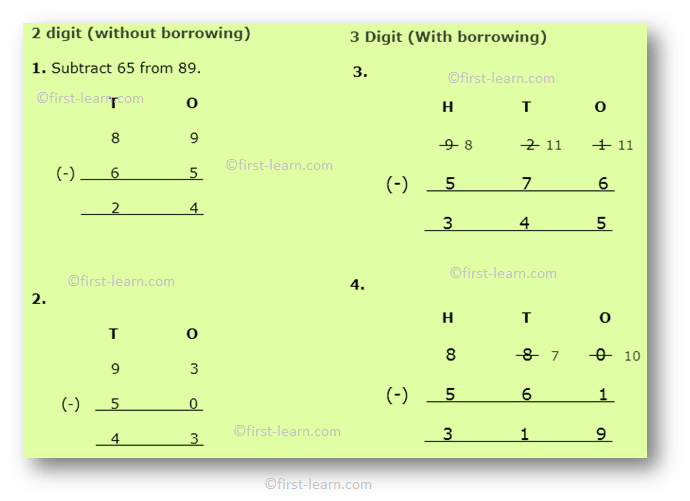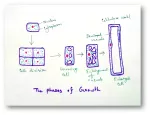Subtraction of Whole Numbers
As we have discussed in previous topics whole number is almost same as natural numbers except the fact that it includes zero. However, natural numbers are {1, 2, 3, 4, 5, 6……} whereas whole numbers are {0, 1, 2, 3, 4, 5, 6, 7……}. Hence we can say that all natural numbers are whole numbers but all whole numbers are not natural numbers as it includes zero. Whole numbers are sometimes termed as counting number. However, counting number does not include zero as zero cannot be counted. Therefore counting numbers including zero is termed as whole number.
The four basic operations with whole numbers are addition, subtraction, multiplication, and division. Now we will understand how subtraction of whole numbers is done.
Steps for conducting subtraction of whole numbers:
I. First we have to write the numbers under proper heads of ones, tens, hundreds, thousands, ten thousands……..etc.
II. Then we have to start subtracting from the right hand side. Subtraction can be with borrowing or without borrowing. If borrowing is needed then we have to borrow from the tens column to make adjustment in the ones column. Accordingly if borrowing is needed in the tens column then we will have to borrow from the hundreds column to make adjustment in the tens column and so on and so forth we have to continue likewise.
Solved Examples of Subtraction of Whole Numbers:
2 digit (without borrowing)
1. Subtract 65 from 89.
T O
8 9
(-) 6 5
2 4
In ones place 5 is subtracted from 9 to get 4 and in the tens place 6 is subtracted from 8 to get 2.
2.
T O
9 3
(-) 5 0
4 3
In ones place 0 is subtracted from 3 to get 3 and in tens place 5 is subtracted from 9 to get 4.
3 Digit (Without borrowing)
3.
H T O
9 8 7
( -) 6 5 4
3 3 3
In ones place 4 is subtracted from 7 to get 3 and in tens place 5 is subtracted from 8 to get 3. Similarly 6 is subtracted from 9 to get 3.
4.
H T O
4 5 6
(-) 1 2 3
3 3 3
In ones place 3 is subtracted from 6 to get 3 and in tens place 2 is subtracted from 5 to get 3. Similarly 1 is subtracted from 4 to get 3.
3 Digit (With borrowing)
5.
H T O
9 8 2 11 1 11
(-) 5 7 6
3 4 5
6 cannot be subtracted from 1. Hence 1 is borrowed to make the number in the ones place as 11. So the number in the tens place that is 2 became 1. Now same issue in the tens place that is 7 cannot be subtracted from 1 again. Hence, 1 is borrowed from 9 to make it 8. Now in the tens place after borrowing 7 can be subtracted from 11. Finally in the hundreds place there is no need of borrowing as 5 can be subtracted from 8.
6.
H T O
8 8 7 0 10
(-) 5 6 1
3 1 9
0 cannot be subtracted from 1. Hence 1 is borrowed to make the number in the ones place as 10. So the number in the tens place that is 8 became 7. Now 6 can be subtracted from 7 in the tens place so no borrowing from the hundreds place required.
The same rule of subtraction with borrowing is prevalent for 4 digit, 5 digit, 6 digit and so on for every number.
From Subtraction of Whole Numbers to HOME PAGE
Recent Articles
-
Explain about Growth in Plants |Definition of Growth & Differentiation
Feb 27, 25 02:07 PM
Growth is a permanent increase in length or volume of an organism that brought upon by an increase in its dimensions due to synthesis of new protoplasmic material. -
Definition of Respiratory Quotient | calculation | Application | Plant
Dec 02, 24 12:09 AM
Definition of respiration quotient- the ratio of the carbon-dioxide evolved to that of the oxygen consumed by a cell, tissue, plants or animals in a given time is called respiratory quotient. It is us… -
Amphibolic Pathway | Definition | Examples | Pentose Phosphate Pathway
Jun 06, 24 10:40 AM
Definition of amphibolic pathway- Amphibolic pathway is a biochemical pathway where anabolism and catabolism are both combined together. Examples of amphibolic pathway- there are different biochemical… -
Respiratory Balance Sheet | TCA Cycle | ATP Consumption Process
Feb 18, 24 01:56 PM
The major component that produced during the photosynthesis is Glucose which is further metabolised by the different metabolic pathways like glycolysis, Krebs cycle, TCA cycle and produces energy whic… -
Electron Transport System and Oxidative Phosphorylation | ETC |Diagram
Feb 04, 24 01:57 PM
It is also called ETC. Electron transfer means the process where one electron relocates from one atom to the other atom. Definition of electron transport chain - The biological process where a chains…





New! Comments
Have your say about what you just read! Leave me a comment in the box below.